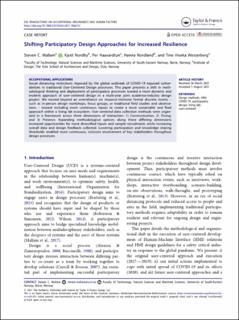| dc.contributor.author | Mallam, Steven | |
| dc.contributor.author | Nordby, Kjetil | |
| dc.contributor.author | Haavardtun, Per | |
| dc.contributor.author | Nordland, Hanna | |
| dc.contributor.author | Westerberg, Tine Viveka | |
| dc.date.accessioned | 2022-10-19T11:38:43Z | |
| dc.date.available | 2022-10-19T11:38:43Z | |
| dc.date.created | 2021-11-18T12:03:31Z | |
| dc.date.issued | 2021 | |
| dc.identifier.citation | IISE Transactions on Occupational Ergonomics and Human Factors. 2021, 9 (2), 78-85. | |
| dc.identifier.issn | 2472-5838 | |
| dc.identifier.uri | https://hdl.handle.net/11250/3027061 | |
| dc.description.abstract | Social distancing restrictions imposed by the global outbreak of COVID-19 exposed vulnerabilities in traditional User-Centered Design processes. This paper presents a shift in methodological thinking and deployment of participatory processes toward a more dynamic and resilient approach of user-centered design in a multi-year joint academia-industry design project. We moved beyond an overreliance on resource-intensive formal discrete events – such as in-person design workshops, focus groups, or traditional field studies and observations – toward including more continuous inputs to create a more sustainable and fluid approach within a living lab ecosystem. User-centered data collection methods were organized in a framework across three dimensions of interaction: 1) Communication; 2) Timing; and 3) Presence. Expanding methodological options along these differing dimensions increased opportunities for more diversified inputs and sample recruitment, while increasing overall data and design feedback collected. Lowering participation and knowledge sharing thresholds enabled more continuous, inclusive involvement of key stakeholders throughout design processes. | |
| dc.language.iso | eng | |
| dc.title | Shifting Participatory Design Approaches For Increased Resilience | |
| dc.type | Peer reviewed | |
| dc.type | Journal article | |
| dc.description.version | publishedVersion | |
| dc.source.pagenumber | 78-85 | |
| dc.source.volume | 9 | |
| dc.source.journal | IISE Transactions on Occupational Ergonomics and Human Factors | |
| dc.source.issue | 2 | |
| dc.identifier.doi | 10.1080/24725838.2021.1966131 | |
| dc.identifier.cristin | 1955908 | |
| dc.relation.project | Norges forskningsråd: 296151 | |
| cristin.ispublished | true | |
| cristin.fulltext | original | |
| cristin.qualitycode | 1 | |
